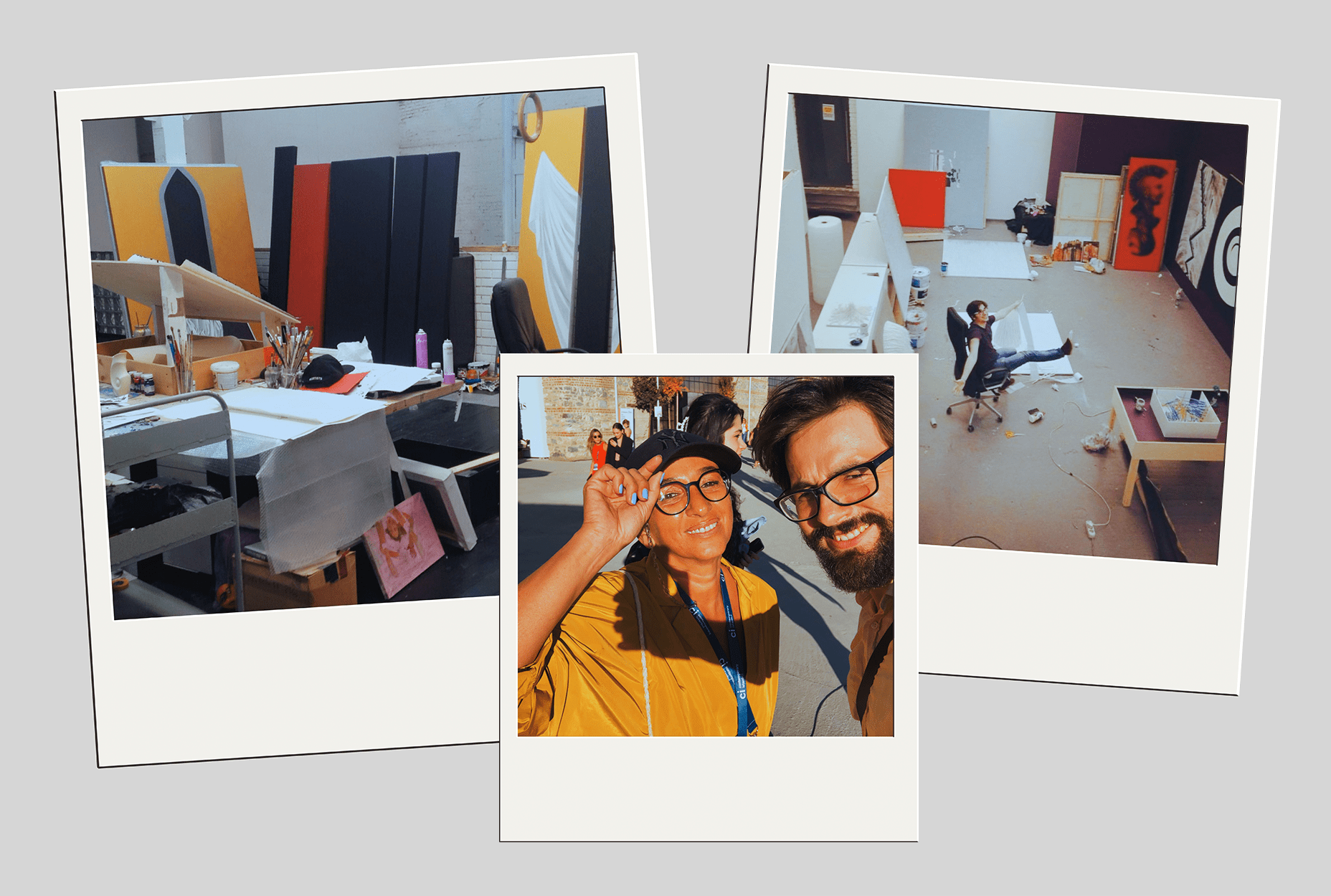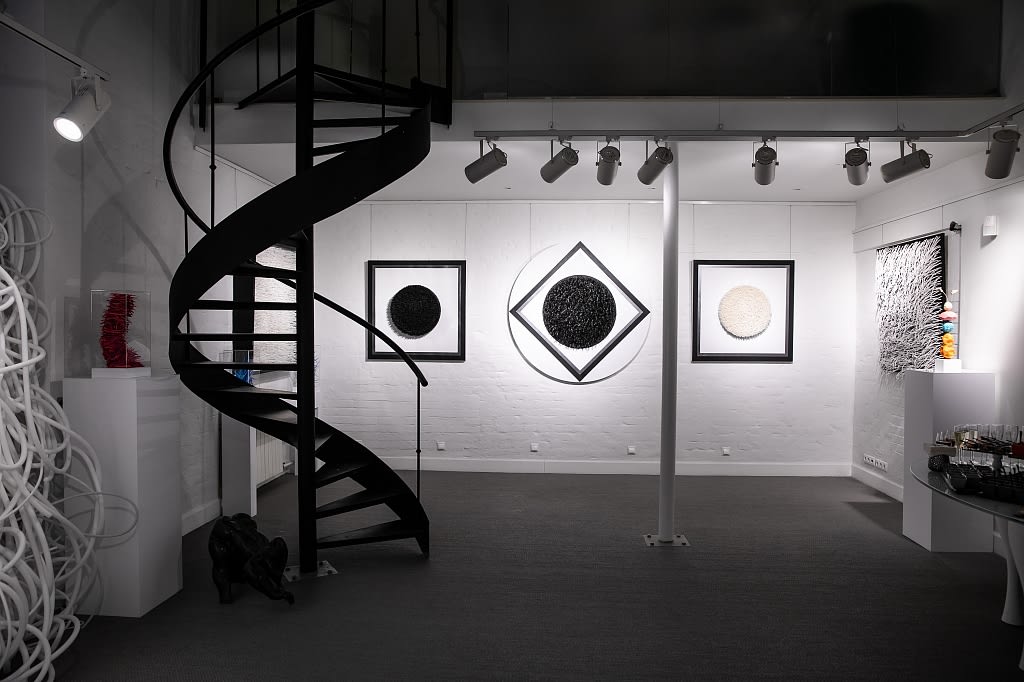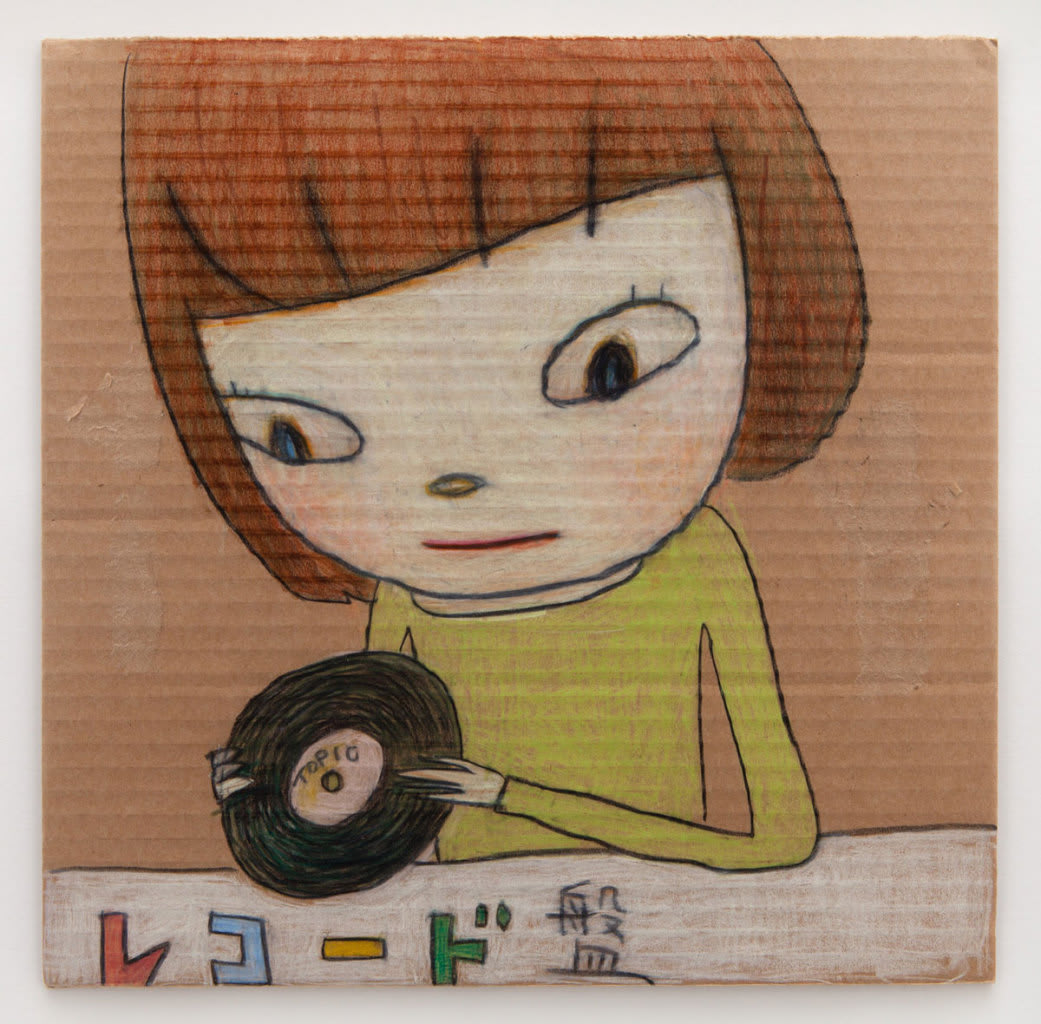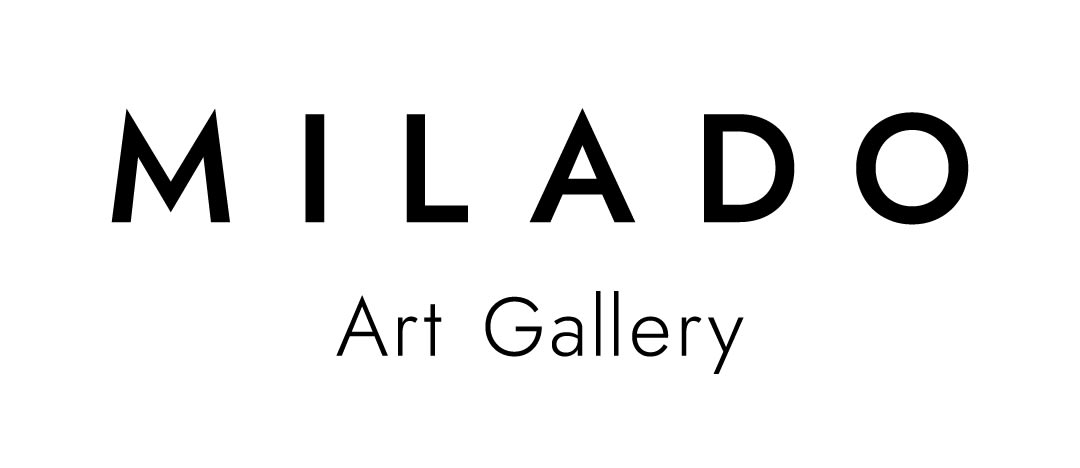MILADO ART GALLERY: When you were a child, who did you dream of becoming? When did you realize you wanted to be an artist?
GLEB SKUBACHEVSKY: For as long as I can remember, I was always drawing. I dreamed of becoming an artist and an archaeologist, though both professions always seemed somewhat unrealistic, almost fantastical, to me. Even now, I’m not very interested in the real world: wars, tsunamis, floods, earthquakes, eruptions, fires - it all feels like a nightmare. I’ve always been drawn instead to the humanities: literature, history, art, and music. I did well in biology too, but I struggled with physics, math, and chemistry. Even though my whole family are physicists, chemists, and mathematicians, I turned out to be the only artist in the family.
MILADO ART GALLERY: You mentioned archaeology and history. How does your interest in these fields manifest in your work?
GLEB SKUBACHEVSKY: Perhaps in the ability to build on what came before me, to keep “digging” - though not into the earth, but into the art itself. And to interpret it not directly, but through my own lens.
MILADO ART GALLERY: Why is it wonderful to be an artist?
GLEB SKUBACHEVSKY: It’s truly extraordinary. I have my own “research laboratory” here in the studio where I can be a researcher, an analyst, a philosopher, and a traveller all at once. I also love adventure. Sometimes I think while others are busy with trivialities, I’m here attempting to create masterpieces (smiles).
MILADO ART GALLERY: You have an exceptional academic background in art, including your studies at the Surikov Moscow State Academic Art Institute. Could you tell us about your experience there? What inspired you, and what was the most challenging?
GLEB SKUBACHEVSKY: It was incredibly intense - an overwhelming and demanding way of studying. We practically lived on campus: there were sofas, kitchens, cafeterias, even gyms. The daily routine was very structured: mornings were devoted to professional drawing, painting, and composition; afternoons were filled with lectures, nearly forty subjects in total, with five different courses in art history alone.
A lot of extraordinary things happened there. And there were plenty of “mavericks” too. I remember one friend being expelled simply because he didn’t show up for exams, insisting that the professors already knew he was fluent in the subject. Another amusing story: we had a professor, Sergei Nikolaevich Shilnikov, who was ninety years old at the time, still teaching painting and composition. One day I was sketching endlessly when he suddenly said: “You know, why don’t you go and draw the homeless people instead” (smiles).
MILADO ART GALLERY: What set you apart from the other students at the institute?
GLEB SKUBACHEVSKY: I think I was able to solve tasks faster than anyone else when it came to sketches, ideas, and concepts. And I was just a relentless worker: I kept pushing until something worked, reworking pieces again and again to make them better. That’s probably what set me apart.
MILADO ART GALLERY: Why is an art education important? From your experience, does an artist need higher education in order to succeed?
GLEB SKUBACHEVSKY: It’s absolutely possible to become successful without formal education - there are plenty of examples of young artists who’ve done so. But I had a particular program instilled in me. I studied at an art school where we were taught to believe you had to follow a very specific path. Before you could create freely, you first had to master the classics, the foundation. Picasso was shown to us as a great example: by the age of 14 or 16, he could already draw anything brilliantly, and only after mastering academic technique did he move on to cubism and everything else.
I never resisted academic training; in fact, I began very much as an academic painter. If you look at my diploma work, it echoes socialist realism. It was a historical painting of a Viking longship sailing into the sunset somewhere in Old Russia. But even then, I always felt the urge to go further, to evolve, to search for something new.
MILADO ART GALLERY: You previously said that a turning point in your artistic path came when you joined Aidan Salakhova’s studio [Aidan Salakhova is a prominent Russian multidisciplinary artist practicing sculpture, painting, photography and installation]. Could you tell us more about that experience?
GLEB SKUBACHEVSKY: That was in my third year of study. I applied to join Aidan Salakhova’s contemporary art studio, and everyone thought I had lost my mind - they couldn’t understand why I would want to do that. But in the end, surprisingly, they all enrolled too. At first, it was extremely difficult. Aidan [Salakhova] told us: “Forget everything you were taught before; from now on everything will be different.” And it truly was a catastrophe. For the first year or two, I had no idea what was expected of me. I tried different approaches, drew at random, and only rarely did I get it right. Before, we had been trained to draw “like in the 19th century” - sketches, life drawing, academic exercises. And then suddenly someone comes along and says: “You must draw and take inspiration from within yourself, from what disturbs you. Abandon conventions and bring it all to the surface.” At the time, we simply couldn’t grasp what was happening to us.
 Gleb in Aidan Salakhova’s art studio, 2016. Images courtesy of Gleb Skubachevsky.
Gleb in Aidan Salakhova’s art studio, 2016. Images courtesy of Gleb Skubachevsky.
MILADO ART GALLERY: When did you become comfortable working in abstraction? What prompted your shift from 2D to 3D?
GLEB SKUBACHEVSKY: In 2013, I started creating two-meter postmodern reinterpretations of the great masters. For example, instead of Munch’s The Scream, I replaced the figure with a screaming emoji; in Snyders’ The Butcher’s Shop, I inserted the McDonald’s logo and titled it Happy Meal. The entire series sold, which was enormously encouraging. After that, Aidan took me on as an assistant, introduced me to my first gallerist, Alexander Sharov, and that’s how I entered the Russian art market.
Then came abstraction: huge two-meter canvases with coloured stripes radiating in every direction. With these stripes, I painted mountains, the sea, and different figures. I brought this work to Montenegro, to Marat Gelman’s studio.
 Gleb in Marat Gelman’s studio, Montenegro, 2019. Image courtesy of Gleb Skubachevsky.
Gleb in Marat Gelman’s studio, Montenegro, 2019. Image courtesy of Gleb Skubachevsky.
At the time, I was a fifth-year student and somehow managed to get into the residency almost miraculously. The studio was in the old building of Yugoslavia’s maritime shipping company - abandoned and untouched since the war. Inside it was crumbling, unbearably hot at +40°C, but with an extraordinary view of the sea. The residency kept being extended month after month.
That’s when I turned to paper. I had run out of everything - money, paints, canvases. All I had left was paper. And I thought to myself: I’m an artist, so I must make art from whatever I have. That’s how I came up with the idea of creating the “whiskers” - rolled, tube-like forms that later became my signature. My first major solo exhibition also happened in Montenegro and was dedicated to the underwater world of the Adriatic.
MILADO ART GALLERY: In your Alien Creatures series, you turn to other forms of life and explore the possibilities of a form. What does this series mean to you?
GLEB SKUBACHEVSKY: I see this series as a search for a vast, universal theme - a laboratory for studying different forms of life, both on Earth and beyond: in space, under water, and above water. Some works feature tiny, microscopic beings; others, imagined inhabitants of distant planets. They all carry a sense of detachment and self-containment.
For me, Alien Creatures is a form of meditation and is all about turning inward. The process of rolling the “whiskers” is tedious - I can sit and roll them for days, as if drifting into space. Producing a single large artwork may take over a month. This series is about connecting with myself, delving into depths, and seeking answers within. The format perfectly reflects my nature: meticulous and hyper-perfectionist. As in Map of the Universe, I’m modelling life forms that one day may be discovered. It’s about the unknown and the search for the new.

Gleb Skubachevsky, Alien Creature, 8, 2024 and Purple, 2024. Image courtesy of Gleb Skubachevsky.
MILADO ART GALLERY: Who are these “aliens” to you? You’ve said that at times you approach the creative process like a biologist or scientist. Could you tell us more about this scientific perspective?
GLEB SKUBACHEVSKY: The simplest and most microscopic forms of life - for example, viruses - have always fascinated me. The wife of a photographer I know researches bacteriophages, and she once showed me real electron microscope images of them. They looked almost comical, like tiny spiders. One of them even made its way into my recent Covid series (Bacteriophage, 2025) and was already sold. To me, it became a kind of positive hero, fighting against the “bad characters.”

Bacterias under electron microscopes used by Gleb Skubachevsky as inspiration.
What fascinates me is that this microbial world is invisible to us, yet it surrounds us everywhere. That is extraordinary. Like a scientist, I try to approach these questions from different perspectives - through the cosmos, through the microscope. In fact, my whole family are physicists and chemists, so perhaps this scientific way of thinking comes from them. At one point, I even considered reaching out to research institutes, asking for materials, and collaborating in a laboratory setting.

Gleb Skubachevsky, Bacteriophage, 2025. Image courtesy of Gleb Skubachevsky.
MILADO ART GALLERY: In your Map of the Universe series, you explore the cosmos. What inspired you to turn to this theme?
GLEB SKUBACHEVSKY: Where do we live? What is happening to us? These are the questions that fascinate me most deeply. I once read that the Max Planck Institute produced the most extensive and precise image of the universe ever created. On those maps, the universe appears as a geoid - an oval shape. Map of the Universe is my attempt to capture a fragment of such a map, a way of engaging with and trying to decipher the mystical theories of the cosmos.

Gleb Skubachevsky, Map of the Universe, 1 , 2024; Map of the Universe, 2, 2024; Map of the Universe, 3, 2024. Image courtesy of Gleb Skubachevsky.
MILADO ART GALLERY: Why did you shift from 3D to 2D graphics in this series?
GLEB SKUBACHEVSKY: Before moving to England, I had never worked with graphics. But in London, I encountered an incredible variety of them at art fairs, galleries, and exhibitions. In Russia, you hardly see this - almost no one works in graphics; most artists use large canvases. What fascinated me about graphics was the speed, and it also allows me to experiment with textures, colours, and combinations, enabling me to create entire series very quickly.
MILADO ART GALLERY: Did your approach to graphics change after your extensive practice with 3D artworks?
GLEB SKUBACHEVSKY: Working in 2D allows me to move quickly and “release steam” after the long, demanding process of creating large 3D objects. Yet I constantly miss volume - I crave space. That’s why my graphics are often heavily textured: I leave bold brushstrokes and sometimes even create what I call “colour whiskers.”

Gleb Skubachevsky in the studio; Plant, 2025. Image courtesy of Gleb Skubachevsky.
MILADO ART GALLERY: What challenges do you encounter in transitioning from large to small canvases?
GLEB SKUBACHEVSKY: Small canvases require extraordinary precision, flexibility, and complexity. They must look compelling from any distance. It’s difficult to achieve nuances at every scale. Now I even work with a needle, adding subtle details or tiny secrets that appear only from certain angles.
MILADO ART GALLERY: In abstract graphic works, how do you know a piece is finished?
GLEB SKUBACHEVSKY: For me, it’s when I feel I’ve reached a certain level of quality - when, in that moment, I simply can’t push it any further. Sometimes I’ll spend an hour making only five strokes, inching forward like in Pan’s Labyrinth. I circle the work, studying it the way a tiger tamer gauges the animal’s next move. At first, it may look complete, but then I realize: no, it isn’t enough; I can do better. Maybe a more complex colour, maybe a bolder brushstroke. Right now, I’m working on boldness. That’s difficult, because the pursuit of perfection makes you tighten up, when what you really need is to let go and swing the brush freely. And that’s terrifying, because in that moment, you might ruin everything.
MILADO ART GALLERY: In 2025, you created a series of graphics dedicated to Covid. Why did you return to the subject after several post-Covid years? How do you manage to make the virus appear both frightening and beautiful?
GLEB SKUBACHEVSKY: I came back to it only now because I could finally see it from a distance, and that perspective makes the work more honest. I wanted to try showing humanity’s most terrifying diseases in an aesthetically beautiful way. I also tried taking the diseases’ side and “listening” to how they might feel. They’ve been around much longer than us; to them, we’re the aliens, not the other way around. And when you look at this supposed “horror” under a microscope, it appears strangely beautiful.

Gleb Skubachevsky, Macrophage cell, 2025; Bacteria, 2025; Flu, 2025. Image courtesy of Gleb Skubachevsky.
MILADO ART GALLERY: Could you tell us about the technique for this series? Did pointillism inspire you? Why that method?
GLEB SKUBACHEVSKY: Pointillism turned out to be a perfect fit. Microscope images are often grainy because of the extreme magnification; you can’t achieve complete sharpness at that scale.
MILADO ART GALLERY: The works in this series are bright, lively, and positive. Why did you choose that colour palette?
GLEB SKUBACHEVSKY: My art is generally very positive. The same happened with microbes - I brightened them up a little. In reality, photographs at that magnification are black-and-white; molecules themselves are almost colourless. But once processed through a computer, they’re colorised so we can better grasp what’s happening. The result is colourful, cheerful, and energetic - a striking contrast with the virus’s often lethal effect. I’m still very afraid of the diseases, almost terrified, but here I tried to look at them from a different angle.
MILADO ART GALLERY: The word “fear” keeps coming up. Would you say fear drives your work?
GLEB SKUBACHEVSKY: Yes, that’s an interesting point. There are so many fears, especially now: fear of migration, moving to a new country, uncertainty, fear for one’s career, wars, climate change - the list is endless. I think fear is an incredibly powerful force; it can push you to new heights in art. For me, it’s like professional sport, an infinite Olympics, a race without a finish line. Fear is my “steroid.” Aidan [Salakhova] taught us not to fear ourselves, but to be honest with ourselves. It’s still scary, but now I know how to manage and overcome that fear. Art is one of the ways.
MILADO ART GALLERY: You moved to London in 2023. What was that experience like? Why London, and where in London are you working now?
GLEB SKUBACHEVSKY: I could write a book about that journey. It was unbelievable. I left in the first days of the war, driving through Verkhnii Lars [Russia-Georgia border crossing], trying to reach Georgia. I slept at gas stations in a snowstorm, ended up in the North Caucasus, spent three months in Georgia, then a year in Turkey, and later returned to Georgia again. Finally, I received a talent visa and flew to England.
In London, I’ve experienced the best art scene I’ve ever known. I’ve never seen such diversity, openness, and intensity of art life - exhibitions, auctions, openings, new people, new artists - it never stops. London has an incredible number of artists; ask anyone on the street, and the chances are high that they’re an artist.
My studio now is at Bow Arts Studios, it is a vast open hangar where everyone can drop in to see each other’s work. It’s both stimulating and empowering: watching other artists at work makes you want to work harder as well. I also feel strong support from the community, both local and international, with also many fellow Russians among them.

Gleb Skubachevsky in his studio. Image courtesy of Gleb Skubachevsky.
MILADO ART GALLERY: Why do you believe so many Russian artists are leaving Russia? What holds the Russian art market back?
GLEB SKUBACHEVSKY: Russia has always produced professionals who eventually matured and left for the West, it’s been this way for centuries. Over the last 30 years, the Russian art market has remained regional. The reason is geopolitical instability and uncertainty about the future. This affects investors, gallerists, and buyers. There’s no guarantee of stability and calmness, for 30 years for instance, which makes it difficult to invest or open branches of major galleries with confidence it wouldn’t be taken away.
In Russia, it’s a constant “rock ’n’ roll”: conflicts, confrontations, the urge to conquer or reclaim something. No one wants to work under such conditions. What’s needed the most is stability: to love everyone, be friends with everyone, and invest in development - art, medicine, education. Russia doesn’t have that.
MILADO ART GALLERY: In your In Regeneration series, you reference the Russian avant-garde. What inspires you now? What are you currently working on?
 In Regeneration exhibition in Askeri Gallery, 2019. Image courtesy of Askeri Gallery.
In Regeneration exhibition in Askeri Gallery, 2019. Image courtesy of Askeri Gallery.
GLEB SKUBACHEVSKY: I draw inspiration from many great artists. Anselm Kiefer’s huge, textured canvases - this is “nourishing” art. I recently went to see a large Yoshitomo Nara exhibition – and it was absolutely stunning! He’s simply obsessed with drawing: he draws on everything, and constantly. His space is overflowing with sketches, studies, finished works. I was struck by the sharpness, immediacy and speed of his work. That’s where I fall short, I like to work slowly and meticulously. Nara works fast, intuitively yet with incredible quality.

Yoshitomo Nara, レコード盤 (Schallplatten), 2012. Image courtesy of Yoshitomo Nara and Blum Gallery.
I was so inspired by his cardboard works that I cut up all my Amazon boxes at home. I started drawing on the same boxes that my sets of paints had arrived in, upcycling them into canvases. For me, this is an experiment that embraces the unpredictability of surprise. I’d call it eco-object-art.

Gleb Skubachevsky, Cardboard experiments, 3, 2025; Cardboard experiments, 4, 2025; Cardboard experiments, 2, 2025. Image courtesy of Gleb Skubachevsky.
MILADO ART GALLERY: What inspires you outside the visual arts?
GLEB SKUBACHEVSKY: My four- and seven-year-old art students have a huge influence on me. I envy them - they’re fearless. From them I learn boldness, simplicity, clarity, and imagination. They remind me to “break myself” and keep trying new things, including object-graphics.
MILADO ART GALLERY: Could you tell us about your creative process? How do you begin a new work - do you sketch, take photos, or work intuitively?
GLEB SKUBACHEVSKY: For 3D works, I make a clear sketch, sometimes in colour, sometimes black-and-white, or I use a photo, and then I replicate it. I love monotonous, meticulous work; it comes naturally to me. Graphics, though, are experimental, like jazz. The expressive, unpredictable, and impulsive elements are harder for me - I have to push beyond my comfort zone.
MILADO ART GALLERY: Why do you consider impulse and expression important to your work?
GLEB SKUBACHEVSKY: It’s like playing a guitar with one string instead of six. You want to use the full range of possibilities, including the technical ones.
MILADO ART GALLERY: How do you think viewers perceive your works?
GLEB SKUBACHEVSKY: I think viewers experience what I’d call an “aesthetic swing”: a layered, ambiguous reaction - interest, curiosity, investigation. They wonder, “What is it made of? How is it done?” However, I admire the kind of artistic egoism Picasso had - he was a genius. His paradox was that he made viewers care about what mattered to him. He essentially said: “I love this, I’ll paint this, and you will admire it.”
MILADO ART GALLERY: How do you think AI and new technologies affect art?
GLEB SKUBACHEVSKY: For digital art to feel real, it has to be infused with soul, with the warmth of human hands. Paintings carry our emotions, energy, and feelings. AI creates linearly, with zeros and ones; there’s no heart or emotional resonance there. I spend a long time charging my works with energy, and later the canvas releases it back to the viewer. The intensity of my input determines the intensity of what the viewer feels. You can’t deceive anyone here.
MILADO ART GALLERY: What trends in art would you highlight?
GLEB SKUBACHEVSKY: I recently read that to create truly great art, you need a strong myth. Right now, we’re living in the expectation of a new one. It’s very hard to surpass our predecessors; they had more authenticity, while today we mostly re-process. It’s a little sad, even frightening, that contemporary art, like a vast oak, has branched out into infinite directions - a tangle of styles, movements, and artists.
MILADO ART GALLERY: Looking to the future, what direction do you plan to take?
GLEB SKUBACHEVSKY: I want to make sculptures and work with textiles. I’ve already imagined the Aliens’ “whiskers” in ceramics. I also want to make prints, though I restrain myself because I can’t do everything at once. I may return to large formats. I’d like to create eco-friendly art and even make my own paints. I enjoy evolving quickly, working at a high tempo, constantly producing new pieces and experimenting. The studio helps too - a big space where I can spread out.
I also dream of painting a series of English plein-air landscapes in a contemporary style. Painting nature in the studio is nothing like painting it outdoors, in the presence of light, wind, rain, smell and sound.
MILADO ART GALLERY: Sounds incredibly interesting. We’ll be looking forward to it. Thank you so much, Gleb, for the interview.



